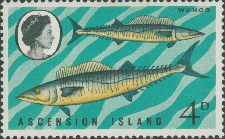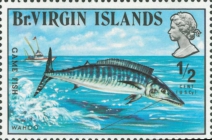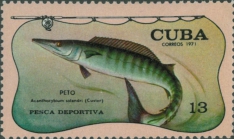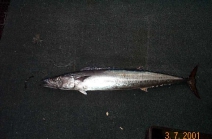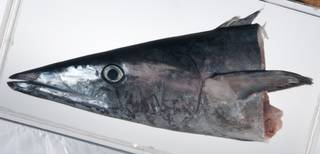WoRMS taxon details
Acanthocybium solandri (Cuvier, 1832)
127014 (urn:lsid:marinespecies.org:taxname:127014)
accepted
Species
Acanthocybium forbesi Seale, 1912 · unaccepted
Acanthocybium petus (Poey, 1860) · unaccepted
Acanthocybium sara (Lay & Bennett, 1839) · unaccepted
Acanthocybium solanderi (Cuvier, 1832) · unaccepted (misspelling)
Acanthocybrium solandri (Cuvier, 1832) · unaccepted (misspelling)
Acanthoscybium solanderi (Cuvier, 1832) · unaccepted (misspelling)
Acantocybium solandri (Cuvier, 1832) · unaccepted (misspelling)
Cybium petus Poey, 1860 · unaccepted
Cybium sara Lay & Bennett, 1839 · unaccepted
Cybium solandri Cuvier, 1832 · unaccepted
Cybium verany Döderlein, 1872 · unaccepted
Jordanidia solandri (Cuvier, 1832) · unaccepted (senior synonym)
Scomber amarui Curtiss, 1938 · unaccepted
marine, brackish, fresh, terrestrial
(of Cybium solandri Cuvier, 1832) Cuvier, G. ; Valenciennes, A. (1832). Histoire naturelle des poissons. Tome huitième. Livre neuvième. Des Scombéroïdes. v. 8: i-xix + 5 pp. + 1-509, Pls. 209-245. [Cuvier authored pp. 1-470; Valenciennes 471-509. Date of 1831 on title page. i-xv + 1-375 in Strasbourg edition.].
page(s): 192 [details]
page(s): 192 [details]
Description An oceanic species frequently solitary or forming small loose aggregations rather than compact schools. Feeds on scombrids,...
Distribution Atlantic, Indian and Pacific: in tropical and subtropical waters, including the Caribbean and Mediterranean seas; as far...
Description An oceanic species frequently solitary or forming small loose aggregations rather than compact schools. Feeds on scombrids, porcupinefishes, flyingfishes, herrings and pilchards, scads, lanternfishes, other pelagic fishes and squids. Each mature female may release 6 million eggs per spawning season (Ref. 9340). An important sport fish in some areas and caught with troll lines, artificial lures, or live bait (Ref. 9340). Marketed fresh, salted or spice-cured (slices of meat); also frozen (Ref. 9987). Flesh of very good quality (Ref. 9684). [details]
Distribution Atlantic, Indian and Pacific: in tropical and subtropical waters, including the Caribbean and Mediterranean seas; as far...
Distribution Atlantic, Indian and Pacific: in tropical and subtropical waters, including the Caribbean and Mediterranean seas; as far north as 44°N in Canadian Atlantic [details]
Froese, R. and D. Pauly. Editors. (2025). FishBase. Acanthocybium solandri (Cuvier, 1832). Accessed through: World Register of Marine Species at: https://www.marinespecies.org/aphia.php?p=taxdetails&id=127014 on 2025-01-06
Date
action
by
![]() The webpage text is licensed under a Creative Commons Attribution-Noncommercial 4.0 License
The webpage text is licensed under a Creative Commons Attribution-Noncommercial 4.0 License
original description
(of Cybium solandri Cuvier, 1832) Cuvier, G. ; Valenciennes, A. (1832). Histoire naturelle des poissons. Tome huitième. Livre neuvième. Des Scombéroïdes. v. 8: i-xix + 5 pp. + 1-509, Pls. 209-245. [Cuvier authored pp. 1-470; Valenciennes 471-509. Date of 1831 on title page. i-xv + 1-375 in Strasbourg edition.].
page(s): 192 [details]
context source (Deepsea) Intergovernmental Oceanographic Commission (IOC) of UNESCO. The Ocean Biogeographic Information System (OBIS), available online at http://www.iobis.org/ [details]
context source (HKRMS) Hong Kong marine fish database. <em>AFCD.</em> , available online at https://www.hk-fish.net/en/fish/introduction/ [details]
context source (Bermuda) Smith-Vaniz, W. F.; Collette, B. B.; Luckhurst, B. E (1999). Fishes of Bermuda: History, zoogeography, annotated checklist, and identification keys (American Society of Ichthyologists and Herpetologists - Special Publication No.4) . ASIH, 424 pp. [details]
context source (PeRMS) Chirichigno, N.; Cornejo, M. (2001). Catálogo comentado de los peces marinos del Perú. <em>2ª ed. Instituto del Mar de Perú. Publicación Especial. Callao.</em> 314 p. [details]
basis of record van der Land, J.; Costello, M.J.; Zavodnik, D.; Santos, R.S.; Porteiro, F.M.; Bailly, N.; Eschmeyer, W.N.; Froese, R. (2001). Pisces, <B><I>in</I></B>: Costello, M.J. <i>et al.</i> (Ed.) (2001). <i>European register of marine species: a check-list of the marine species in Europe and a bibliography of guides to their identification. Collection Patrimoines Naturels,</i> 50: pp. 357-374 (look up in IMIS) [details]
additional source Gulf of Maine Biogeographic Information System (GMBIS) Electronic Atlas. 2002. November, 2002. [details]
additional source King, C.M.; Roberts, C.D.; Bell, B.D.; Fordyce, R.E.; Nicoll, R.S.; Worthy, T.H.; Paulin, C.D.; Hitchmough, R.A.; Keyes, I.W.; Baker, A.N.; Stewart, A.L.; Hiller, N.; McDowall, R.M.; Holdaway, R.N.; McPhee, R.P.; Schwarzhans, W.W.; Tennyson, A.J.D.; Rust, S.; Macadie, I. (2009). Phylum Chordata: lancelets, fishes, amphibians, reptiles, birds, mammals. <em>in: Gordon, D.P. (Ed.) (2009). New Zealand inventory of biodiversity: 1. Kingdom Animalia: Radiata, Lophotrochozoa, Deuterostomia.</em> pp. 431-554. [details]
additional source McEachran, J. D. (2009). Fishes (Vertebrata: Pisces) of the Gulf of Mexico, Pp. 1223–1316 in: Felder, D.L. and D.K. Camp (eds.), Gulf of Mexico–Origins, Waters, and Biota. Biodiversity. Texas A&M Press, College Station, Texas. [details]
additional source Liu, J.Y. [Ruiyu] (ed.). (2008). Checklist of marine biota of China seas. <em>China Science Press.</em> 1267 pp. (look up in IMIS) [details] Available for editors [request]
[request]
additional source Froese, R. & D. Pauly (Editors). (2024). FishBase. World Wide Web electronic publication. version (06/2024)., available online at https://www.fishbase.org [details]
ecology source Looby, A.; Erbe, C.; Bravo, S.; Cox, K.; Davies, H. L.; Di Iorio, L.; Jézéquel, Y.; Juanes, F.; Martin, C. W.; Mooney, T. A.; Radford, C.; Reynolds, L. K.; Rice, A. N.; Riera, A.; Rountree, R.; Spriel, B.; Stanley, J.; Vela, S.; Parsons, M. J. G. (2023). Global inventory of species categorized by known underwater sonifery. <em>Scientific Data.</em> 10(1). (look up in IMIS), available online at https://doi.org/10.1038/s41597-023-02745-4 [details]
page(s): 192 [details]
context source (Deepsea) Intergovernmental Oceanographic Commission (IOC) of UNESCO. The Ocean Biogeographic Information System (OBIS), available online at http://www.iobis.org/ [details]
context source (HKRMS) Hong Kong marine fish database. <em>AFCD.</em> , available online at https://www.hk-fish.net/en/fish/introduction/ [details]
context source (Bermuda) Smith-Vaniz, W. F.; Collette, B. B.; Luckhurst, B. E (1999). Fishes of Bermuda: History, zoogeography, annotated checklist, and identification keys (American Society of Ichthyologists and Herpetologists - Special Publication No.4) . ASIH, 424 pp. [details]
context source (PeRMS) Chirichigno, N.; Cornejo, M. (2001). Catálogo comentado de los peces marinos del Perú. <em>2ª ed. Instituto del Mar de Perú. Publicación Especial. Callao.</em> 314 p. [details]
basis of record van der Land, J.; Costello, M.J.; Zavodnik, D.; Santos, R.S.; Porteiro, F.M.; Bailly, N.; Eschmeyer, W.N.; Froese, R. (2001). Pisces, <B><I>in</I></B>: Costello, M.J. <i>et al.</i> (Ed.) (2001). <i>European register of marine species: a check-list of the marine species in Europe and a bibliography of guides to their identification. Collection Patrimoines Naturels,</i> 50: pp. 357-374 (look up in IMIS) [details]
additional source Gulf of Maine Biogeographic Information System (GMBIS) Electronic Atlas. 2002. November, 2002. [details]
additional source King, C.M.; Roberts, C.D.; Bell, B.D.; Fordyce, R.E.; Nicoll, R.S.; Worthy, T.H.; Paulin, C.D.; Hitchmough, R.A.; Keyes, I.W.; Baker, A.N.; Stewart, A.L.; Hiller, N.; McDowall, R.M.; Holdaway, R.N.; McPhee, R.P.; Schwarzhans, W.W.; Tennyson, A.J.D.; Rust, S.; Macadie, I. (2009). Phylum Chordata: lancelets, fishes, amphibians, reptiles, birds, mammals. <em>in: Gordon, D.P. (Ed.) (2009). New Zealand inventory of biodiversity: 1. Kingdom Animalia: Radiata, Lophotrochozoa, Deuterostomia.</em> pp. 431-554. [details]
additional source McEachran, J. D. (2009). Fishes (Vertebrata: Pisces) of the Gulf of Mexico, Pp. 1223–1316 in: Felder, D.L. and D.K. Camp (eds.), Gulf of Mexico–Origins, Waters, and Biota. Biodiversity. Texas A&M Press, College Station, Texas. [details]
additional source Liu, J.Y. [Ruiyu] (ed.). (2008). Checklist of marine biota of China seas. <em>China Science Press.</em> 1267 pp. (look up in IMIS) [details] Available for editors
additional source Froese, R. & D. Pauly (Editors). (2024). FishBase. World Wide Web electronic publication. version (06/2024)., available online at https://www.fishbase.org [details]
ecology source Looby, A.; Erbe, C.; Bravo, S.; Cox, K.; Davies, H. L.; Di Iorio, L.; Jézéquel, Y.; Juanes, F.; Martin, C. W.; Mooney, T. A.; Radford, C.; Reynolds, L. K.; Rice, A. N.; Riera, A.; Rountree, R.; Spriel, B.; Stanley, J.; Vela, S.; Parsons, M. J. G. (2023). Global inventory of species categorized by known underwater sonifery. <em>Scientific Data.</em> 10(1). (look up in IMIS), available online at https://doi.org/10.1038/s41597-023-02745-4 [details]
 Present
Present  Present in aphia/obis/gbif/idigbio
Present in aphia/obis/gbif/idigbio  Inaccurate
Inaccurate  Introduced: alien
Introduced: alien  Containing type locality
Containing type locality
Unreviewed
Description An oceanic species frequently solitary or forming small loose aggregations rather than compact schools. Feeds on scombrids, porcupinefishes, flyingfishes, herrings and pilchards, scads, lanternfishes, other pelagic fishes and squids. Each mature female may release 6 million eggs per spawning season (Ref. 9340). An important sport fish in some areas and caught with troll lines, artificial lures, or live bait (Ref. 9340). Marketed fresh, salted or spice-cured (slices of meat); also frozen (Ref. 9987). Flesh of very good quality (Ref. 9684). [details]Diet Feeds on fishes and squids [details]
Distribution Atlantic, Indian and Pacific: in tropical and subtropical waters, including the Caribbean and Mediterranean seas; as far north as 44°N in Canadian Atlantic [details]
Habitat An oceanic, epipelagic species frequently solitary or forming small loose aggregations rather than compact schools. [details]
Habitat nektonic [details]
Habitat Known from seamounts and knolls [details]
Importance Social- Commercial, fishery and gamefish [details]
Remark Date Eschmeyer, pers. comm. [details]
To Barcode of Life (157 barcodes)
To Biodiversity Heritage Library (11 publications) (from synonym Cybium solandri Cuvier, 1832)
To Biodiversity Heritage Library (21 publications) (from synonym Acanthocybium solanderi (Cuvier, 1832))
To Biodiversity Heritage Library (23 publications) (from synonym Acanthocybium petus (Poey, 1860))
To Biodiversity Heritage Library (27 publications) (from synonym Cybium sara Lay & Bennett, 1839)
To Biodiversity Heritage Library (3 publications) (from synonym Cybium verany Döderlein, 1872)
To Biodiversity Heritage Library (5 publications) (from synonym Cybium petus Poey, 1860)
To Biodiversity Heritage Library (5 publications) (from synonym Acanthocybium forbesi Seale, 1912)
To Biodiversity Heritage Library (71 publications)
To Biodiversity Heritage Library (9 publications) (from synonym Acanthocybium sara (Lay & Bennett, 1839))
To Biological Information System for Marine Life (BISMaL)
To Biological Information System for Marine Life (BISMaL) (from synonym Cybium solandri Cuvier, 1832)
To European Nucleotide Archive, ENA (Acanthocybium solandri)
To FishBase (from synonym Acanthocybium petus (Poey, 1860))
To FishBase (from synonym Scomber amarui Curtiss, 1938)
To FishBase (from synonym Cybium petus Poey, 1860)
To FishBase (from synonym Acanthocybium sara (Lay & Bennett, 1839))
To FishBase
To FishBase (from synonym Acanthocybium forbesi Seale, 1912)
To FishBase (from synonym Cybium verany Döderlein, 1872)
To FishBase (from synonym Cybium sara Lay & Bennett, 1839)
To FishBase (from synonym Cybium solandri Cuvier, 1832)
To FishBase (from synonym Acanthocybium solanderi (Cuvier, 1832))
To FishBase (from synonym Acantocybium solandri (Cuvier, 1832))
To FishBase (from synonym Acanthoscybium solanderi (Cuvier, 1832))
To FishBase (from synonym Acanthocybrium solandri (Cuvier, 1832))
To FishBase images (Acanthocybium solandri, Niue, by University of Western Australia (UWA))
To GenBank (493 nucleotides; 260 proteins)
To GenBank (493 nucleotides; 260 proteins) (from synonym Cybium solandri Cuvier, 1832)
To Global Biotic Interactions (GloBI)
To IUCN Red List (Least Concern)
To NMNH Extant Collection (Acanthocybium solandri USNM 405884 photograph head lateral view)
To PESI
To ITIS
To Biodiversity Heritage Library (11 publications) (from synonym Cybium solandri Cuvier, 1832)
To Biodiversity Heritage Library (21 publications) (from synonym Acanthocybium solanderi (Cuvier, 1832))
To Biodiversity Heritage Library (23 publications) (from synonym Acanthocybium petus (Poey, 1860))
To Biodiversity Heritage Library (27 publications) (from synonym Cybium sara Lay & Bennett, 1839)
To Biodiversity Heritage Library (3 publications) (from synonym Cybium verany Döderlein, 1872)
To Biodiversity Heritage Library (5 publications) (from synonym Cybium petus Poey, 1860)
To Biodiversity Heritage Library (5 publications) (from synonym Acanthocybium forbesi Seale, 1912)
To Biodiversity Heritage Library (71 publications)
To Biodiversity Heritage Library (9 publications) (from synonym Acanthocybium sara (Lay & Bennett, 1839))
To Biological Information System for Marine Life (BISMaL)
To Biological Information System for Marine Life (BISMaL) (from synonym Cybium solandri Cuvier, 1832)
To European Nucleotide Archive, ENA (Acanthocybium solandri)
To FishBase (from synonym Acanthocybium petus (Poey, 1860))
To FishBase (from synonym Scomber amarui Curtiss, 1938)
To FishBase (from synonym Cybium petus Poey, 1860)
To FishBase (from synonym Acanthocybium sara (Lay & Bennett, 1839))
To FishBase
To FishBase (from synonym Acanthocybium forbesi Seale, 1912)
To FishBase (from synonym Cybium verany Döderlein, 1872)
To FishBase (from synonym Cybium sara Lay & Bennett, 1839)
To FishBase (from synonym Cybium solandri Cuvier, 1832)
To FishBase (from synonym Acanthocybium solanderi (Cuvier, 1832))
To FishBase (from synonym Acantocybium solandri (Cuvier, 1832))
To FishBase (from synonym Acanthoscybium solanderi (Cuvier, 1832))
To FishBase (from synonym Acanthocybrium solandri (Cuvier, 1832))
To FishBase images (Acanthocybium solandri, Niue, by University of Western Australia (UWA))
To GenBank (493 nucleotides; 260 proteins)
To GenBank (493 nucleotides; 260 proteins) (from synonym Cybium solandri Cuvier, 1832)
To Global Biotic Interactions (GloBI)
To IUCN Red List (Least Concern)
To NMNH Extant Collection (Acanthocybium solandri USNM 405884 photograph head lateral view)
To PESI
To ITIS
From editor or global species database
Unreviewed



